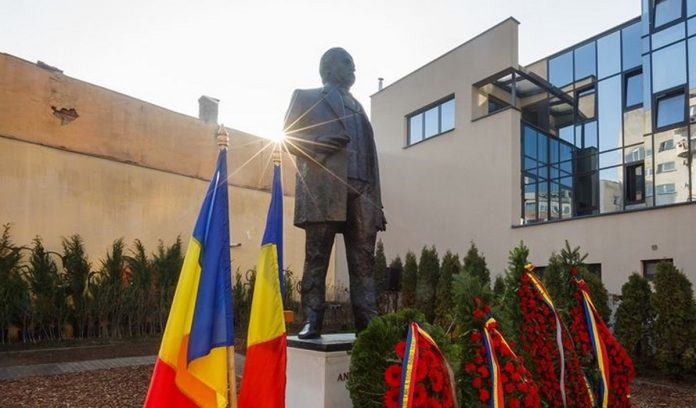The bronze statue, six meters high, of the poet and revolutionary Andrei Muresanu, the one who wrote the lyrics of the Romanian national anthem „Wake up, Romanians”, has been for almost 90 years the second symbol of Bistrita municipality, after the Evangelical Church in the historic center, seven centuries old, write Agerpres.
The poet Andrei Muresanu, born in Bistrita, on November 16, 1816, became a symbol of the Revolution of 1848, the year in which he also wrote the poem „Un rasunet”, which would enliven the Romanians’ struggle for freedom throughout the ages, accompanied by the music of Anton Pann. Currently, the two symbols of Bistrita – the statue of the poet and the Evangelical Church – are located a few meters from each other, in the Central Square of the municipality, since 1946. The steps to erect this statue were started in 1932, at the initiative of a deputy of Nasaud county, a lawyer by profession, Victor Moldovan, who testifies in his „Memoirs” that from the first years of parliamentary activity he was preoccupied with the worship of heroes from the Bistrita and Nasaud, and especially that of „our great bard of our national wisdom”. The deputy turned to the sculptor Cornel Medrea, extremely appreciated in the interwar period, to create the bronze statue of the poet. The statue was brought to Bistrita in 1935, and the foundation stone was laid in September of the same year, in the presence of the descendants of the poet Andrei Muresanu. „When the colossal statue arrived in Bistrita, sitting in my yard, people came as if it were a miracle, the people of Bistrita not having the opportunity to see a bronze monument until then. I chose Unirii Square, in front of the church, as the right place for it to be erected the statue. The descendants of the poet Andrei Muresanu took part in the digging of the foundation,” Victor Moldovan writes in his memoirs. The political changes that took place shortly after the laying of the foundation stone caused the statue to remain for several years in the courtyard of the old prefecture of the county, and its inauguration to be postponed to 1938, as explained by the director of the Bistrita-Nasaud County Service of the National Archives, Cornelia Vlasin. The inauguration of the statue of Andrei Muresanu took place in November 1938, in the presence of Bishop Iuliu Hossu – future cardinal, a representative of King Charles II, as well as local personalities of the time. However, the people of Bistrita did not enjoy the presence of this statue for a long time, because the year 1940 came, and, following the Vienna Dictatorship, the north of Transylvania was ceded to Hungary. The Bistrita authorities retreat to Sibiu. The saving of the statue comes from a colonel of the Romanian Army, who decides to evacuate the statue by train to Sibiu, without informing his superiors beforehand. The statue is displayed in front of Domnita Ileana High School, where it remains until 1946, after the end of the World War II, reports Cornelia Vlasin. The authorities of Bistrita quickly took steps, after the end of the second world conflagration, to bring back the statue of Andrei Muresanu, thus, the monument returned to Bistrita in 1946, but it will not be placed on the old plinth, but near the Evangelical Church, and the inauguration takes place on March 1 of the same year. Since then, the imposing statue of Andrei Muresanu, with one arm raised to the sky, watches over the Central Square in Bistrita, across the street from the town hall, and is the place where every year the local and county officials gather to mark Romania’s National Day , National Anthem Day and National Flag Day. Moreover, the statue was integrated into the coat of arms of the municipality of Bistrita, approved in 1999, thus becoming part of its identity.


